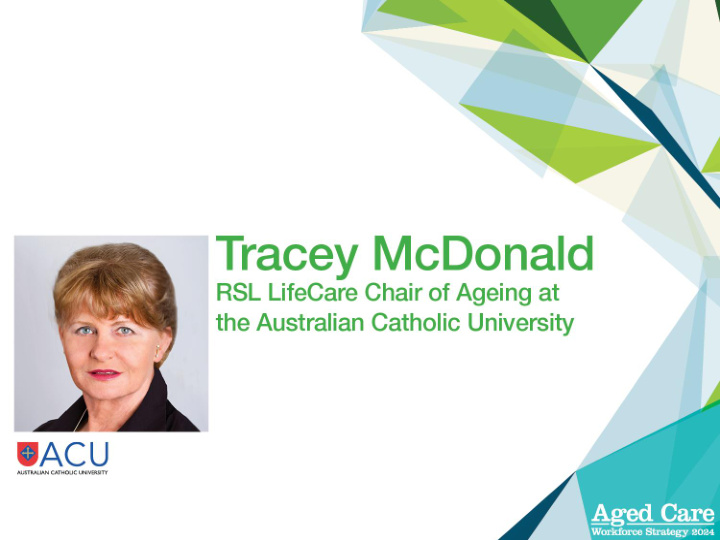



Aged Care Workforce Strategy 2014 26 March 2014, Doltone House, Sydney Professor Tracey McDonald AM FACN PhD RSL LifeCare Chair of Ageing Australian Catholic University
Australians are living 25 years longer than 100 years ago Those >85 will quadruple over next 40 years By 2050 78,000 Australians will be 100+ years old Yes – they will be Generation X … and they are now making the policy that will affect their own dotage … SANDWICH CONTRACTION RETIREMENT GENERATION OF MORBIDITY AGE 70+ PENSION? TRAIL BLAZERS BIG BUSINESS
Nursing services include Preventing health breakdown Promoting healthy living and early detection of problems Treatment and support for those with disease, trauma, emotional and psychological issues Education and coaching for adaptation to change and preservation of social cohesion Residential aged care demand Over 80% of residents are assessed as needing high level care Around 49% have a diagnosed mental illness needing treatment Highly specialised nursing is needed for palliative care services Dementia diagnosis by GPs estimated to be less than 70% accurate Increasing prevalence acquired of brain injury and genetic syndromes as longevity increases
Industry response RN participation in aged care effectively halved over 8 years Substitution of RNs with care assistants employed to follow management designed care protocols Continuing efforts by some providers to further reduce RN participation as clinicians De-activating nursing in aged care practice Mismanagement of nurses as a resource in aged care through lack of vision and management ability Removal of clinical career pathway and replace with management career pathway Ageist employment practices Personal insecurities of managers disadvantage older experienced nurses
Human capital Higher education levels, better health, resilience, self- sufficiency, team orientation, flexibility, professional code They respond to the cohort effect of public expectations of nurses to remain in the workforce because people need them Diminishing resource Increased longevity, decreased fertility and retirement of senior nurses will affect their choices of employer and practice context Employers will be judged on organisational policies around workloads and role designs that place older nurses in precarious financial, social and work situations
Organisations that: Invest in the health of their own employees Acknowledge and respect the professional authority and status of nurses Invest in professional and practice development to enhance nursing clinical skills and expertise Accommodate work demands to the limitations of normal ageing to allow nurses to remain in the workforce Offer a fair workload within a flexible employment environment Are NOT locked into 20 th century models of nursing or central office work delegation
Employers interested in recruiting and retaining nurses should tell them about their: POSTIVE NURSING TALENTED AND ORIENTATION & & OLDER EXPERT RETRAINING WORKER POLICIES NURSING TEAM SUPPORT CLINICAL SAFE WORKING FLEXIBLE CONTEXT ENVIRONMENT WORKING TRANSITION FOR ALL STAFF CONDITIONS SUPPORT SUPPORT FOR TRANSITION TO NURSE SHARING RETIREMENT OF EXPERTISE PROGRAMS
Conduct a regular census of nurses; their clinical experience; qualifications; specialty interests; estimates of retirement within 5 years Think about how flexible nursing work can become and still deliver services to the standard required Know what transition programs exist for new graduates, nurses transferring from other sectors, international and retiring nurses Ensure your workplace culture is free from prejudices Ensure all executives, administrators and managers know the difference between nursing and management; and between management and leadership
Recommend
More recommend